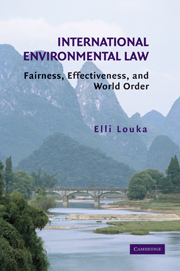Book contents
- Frontmatter
- Contents
- Foreword by W. Michael Reisman
- Abbreviations
- Introduction
- Chapter 1 Introduction to International Environmental Law
- Chapter 2 Foundations of International Environmental Law
- Chapter 3 Compliance and Governance Mechanisms
- Chapter 4 Marine Environment
- Chapter 5 Water Resources
- Chapter 6 Fisheries Resources
- Chapter 7 Biodiversity
- Chapter 8 Air Pollution
- Chapter 9 Trade and Environment
- Chapter 10 Hazardous and Radioactive Wastes
- Chapter 11 Liability and State Responsibility
- International Treaties and Other Instruments
- List of Cases
- Index
Chapter 11 - Liability and State Responsibility
Published online by Cambridge University Press: 14 January 2010
- Frontmatter
- Contents
- Foreword by W. Michael Reisman
- Abbreviations
- Introduction
- Chapter 1 Introduction to International Environmental Law
- Chapter 2 Foundations of International Environmental Law
- Chapter 3 Compliance and Governance Mechanisms
- Chapter 4 Marine Environment
- Chapter 5 Water Resources
- Chapter 6 Fisheries Resources
- Chapter 7 Biodiversity
- Chapter 8 Air Pollution
- Chapter 9 Trade and Environment
- Chapter 10 Hazardous and Radioactive Wastes
- Chapter 11 Liability and State Responsibility
- International Treaties and Other Instruments
- List of Cases
- Index
Summary
Liability and state responsibility rules determine whether the polluter pays principle is a principle of consequence in international environmental law or if it is just a principle that hardly applies in practice. From the regimes examined in this chapter, one gets a mixed picture. Most international liability regimes channel liability to the person who is in control of an environmentally damaging activity. In the case of oil pollution and the sea transfer of hazardous substances, the person in control is the shipowner. In the case of nuclear pollution, it is the operator of a nuclear power plant. In the case of carriage of dangerous goods, it is the carrier of dangerous goods. In the case of waste exports, the person who gives notification to the country of destination that a waste transfer is to take place is the person who is liable until the disposer takes control of the waste. From that point on, the disposer is considered liable. The Lugano Convention similarly holds the operator liable for incidents that result from a dangerous activity.
The channeling of liability to the person in control of a dangerous activity is necessary in order to reduce the transaction costs of finding the responsible person. A presumption, therefore, is made that the person in control of the activity should be the liable person. Liability is strict because a fault liability regime would have created further costs of finding whether the person in control was actually at fault.
- Type
- Chapter
- Information
- International Environmental LawFairness, Effectiveness, and World Order, pp. 448 - 481Publisher: Cambridge University PressPrint publication year: 2006



